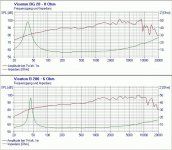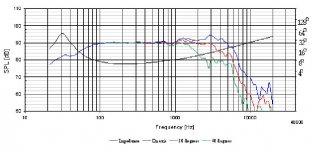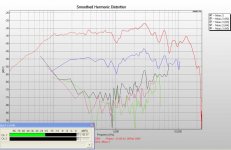Seems like almost every midrange driver has a dip somewhere between 1-2Khz, even very good ones. Anybody know what's the consistent cause for that from driver to driver?
what kind of midrange? If you are referring to a cone (i.e. 4" midbass), then you see the visible effect of beaming. The wavelength becomes smaller than the cone diameter (6" around 1.8 kHz, 5.25" around 2.3 kHz).
I believe its true that most drivers have a problem around 1khz, and noone can say exactly why...or else problem would be solved
It may be visible at impedance too
Some think its related to cone/surround interaction
It may be visible at impedance too
Some think its related to cone/surround interaction
Are you talking about when mounted to a baffle? If so then diffraction would be the first thing that springs to mind particularly as the average baffle width->wavelength would be somewhere in that range.
No, he is talking about floppy polypro drivers, haha. Straight line for ceramics!ShinOBIWAN said:Are you talking about when mounted to a baffle?



crazyhub said:No, he is talking about floppy polypro drivers, haha. Straight line for ceramics!



Yeah, straight line and then a break up peak the size of Dirk Digglers package. Personally I'm not really into that sort of thing. 😀
Your reply is much faster than your drivers!ShinOBIWAN said:
Yeah, straight line and then a break up peak the size of Dirk Digglers package. Personally I'm not really into that sort of thing. 😀
🙄
critofur said:Seems like almost every midrange driver has a dip somewhere between 1-2Khz, even very good ones. Anybody know what's the consistent cause for that from driver to driver?
It is called cone surround dip---tinitus is right. In practice, it isn't that audible since it's usually very narrow.
The dip I'm talking about is the one you see on manufacturer's charts, sometimes followed by a bump. This would typically be measured on-axis on a large baffle in an anechoic chamber.
When I was working with someone who designs and builds his own custom drivers for his company, I referred to it as the dipbump, with our drivers it was around 2Khz and not as severe as in some of the nice Vifa, Peerless, and Audax drivers I'd been looking at.
Having a dip right next to the bump made it less desirable to try to use a notch filter on the bump 🙁
I hadn't done much testing to see if the dip is audible, because, it's so hard to eliminate mechanically. When we did finally succeed in getting a flat response (by spending hours attaching bits of sticky tar in various shapes to the cone) it sounded surprisingly bad.
"cone surround dip" eh? I guess accordion cloth surrounds don't have that issue as much? Maybe the double roll rubber surrounds are little better than the single roll ones also? We even tried cutting the edge of the cone in a zig-zag pattern to see if that would help, it didn't 🙁
When I was working with someone who designs and builds his own custom drivers for his company, I referred to it as the dipbump, with our drivers it was around 2Khz and not as severe as in some of the nice Vifa, Peerless, and Audax drivers I'd been looking at.
Having a dip right next to the bump made it less desirable to try to use a notch filter on the bump 🙁
I hadn't done much testing to see if the dip is audible, because, it's so hard to eliminate mechanically. When we did finally succeed in getting a flat response (by spending hours attaching bits of sticky tar in various shapes to the cone) it sounded surprisingly bad.
"cone surround dip" eh? I guess accordion cloth surrounds don't have that issue as much? Maybe the double roll rubber surrounds are little better than the single roll ones also? We even tried cutting the edge of the cone in a zig-zag pattern to see if that would help, it didn't 🙁
People, including me, already discussed this issue long ago. Take a look at my post:
http://www.diyaudio.com/forums/showthread.php?postid=1236362#post1236362
and Kevin Haskins' post:
http://www.diyaudio.com/forums/showthread.php?postid=1237126#post1237126
I also asked this question at PE forum, and John Kreskovsky gave an essentially the same answer.
http://www.diyaudio.com/forums/showthread.php?postid=1236362#post1236362
and Kevin Haskins' post:
http://www.diyaudio.com/forums/showthread.php?postid=1237126#post1237126
I also asked this question at PE forum, and John Kreskovsky gave an essentially the same answer.
Jay_WJ said:People, including me, already discussed this issue long ago. Take a look at my post:
http://www.diyaudio.com/forums/showthread.php?postid=1236362#post1236362
and Kevin Haskins' post:
http://www.diyaudio.com/forums/showthread.php?postid=1237126#post1237126
I also asked this question at PE forum, and John Kreskovsky gave an essentially the same answer.
I looked at the threads some, I didn't see much discussion about how to modify speakers to reduce the dip, however.
I wouldn't bother to mod. Nearly all 6.5" drivers have a dip around that frequency. The Usher 8945P in my 2-way design has quite a bit of such a dip. With a mild correction through the xover, I don't hear any ill effects of the dip.
I had a bias against foam surrounds because I've had speakers with the foam surrounds rot on them, but, it does seem that foam is generally superior to rubber, sonically.
Graham Maynard said:and another 8" driver, the Peerless 830868 with normal sized foam surround, which does sound as smooth as the traces indicate, so the dips and peaks must be down to cone shape and type.
G.
Hi Graham (/others),
The 831868, formerly 830868, seems to be a Rubber surround.
http://www.madisound.com/catalog/product_info.php?products_id=1610
even with the old number... (if you saw it then maybe, /or they had both?).
http://www.bmm-electronics.com/Product.asp?Product_ID=4285
MisterTwister said:I found measurements ot Usher 8945P woofer,
measured in a box with 11x16 in baffle.
same 1khz dip
What's the length for a 1KHz wave (?)
What's the distance inside the cone between the two faces of the cone (?)
Then maybe is just an anti-phase. It can have a dustcap involved, I am just guessing here.
We had the same problem with expensive inverted dome tweeters a wile back in this forum. We need a pipe for each frequency like in the old times...
Inductor said:
What's the length for a 1KHz wave (?)
What's the distance inside the cone between the two faces of the cone (?)
Wavelength at 1Khz is approximately 340mm. I'd guess the diameter of the cone in the Usher is around 140mm.
- Status
- Not open for further replies.
- Home
- Loudspeakers
- Multi-Way
- Midrange drivers dips above 1Khz...


